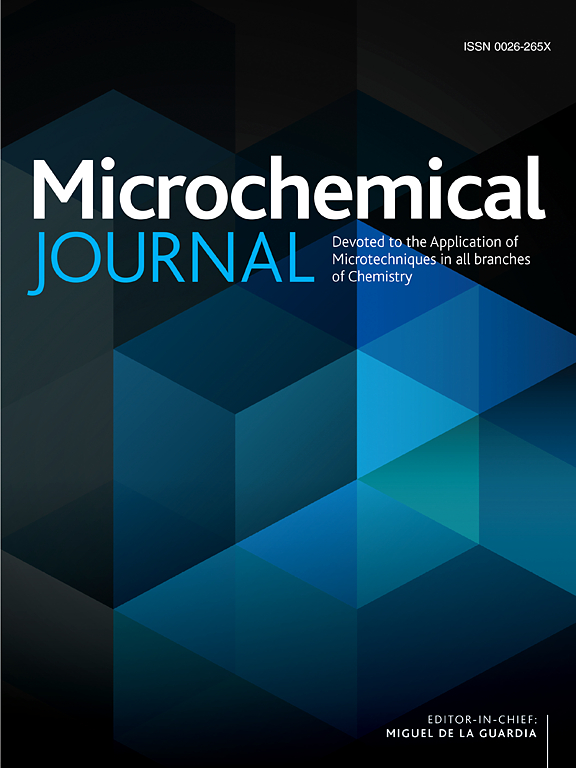利用便携式质谱融合技术提高便携式近红外光谱的准确性和可解释性——以当归地理溯源为例
IF 4.9
2区 化学
Q1 CHEMISTRY, ANALYTICAL
引用次数: 0
摘要
随着消费者对食品质量和安全的要求越来越高,快速准确的原产地追溯变得越来越重要。便携式近红外光谱法(NIR)和便携式质谱法(PMS)在食品真实性评估中显示出各自的优势。然而,目前还没有研究探索将这两种技术结合起来进行原产地鉴定。本研究提出了一种结合近红外和PMS的多层次数据融合策略,以提高当归(Angelica sinensis Radix, ASR)的可追溯准确性。采用马氏距离法剔除异常值后,分别利用近红外和PMS数据建立了基于随机森林、径向基函数神经网络和蛇形优化支持向量机(SO-SVM)的分类模型。采用预处理和变量选择技术来提高模型的鲁棒性。SG-MSC-2nd Der-SO-SVM模型在近红外数据上表现最佳,而SS-CMA-ES-SO-SVM模型在PMS数据上表现最佳。在融合策略中,基于贝叶斯模型平均的方法优于低级和中级融合方法,在独立验证集上达到0.95的准确率和0.91的Kappa值。该研究表明,互补光谱和光谱数据的融合为提高原产地可追溯性提供了强有力的解决方案,并为食品质量监测提供了有价值的参考。本文章由计算机程序翻译,如有差异,请以英文原文为准。

Improving accuracy and interpretability of portable near-infrared spectroscopy via portable mass spectrometry fusion: A case study on the geographical traceability of Angelica sinensis
With growing consumer demand for food quality and safety, rapid and accurate origin traceability has become increasingly important. Portable near-infrared spectroscopy (NIR) and portable mass spectrometry (PMS) have shown respective advantages in food authenticity assessment. However, no study has yet explored the integration of both technologies for origin identification. This study proposes a multilevel data fusion strategy combining NIR and PMS to enhance the traceability accuracy of Angelica sinensis Radix (ASR), a regionally distinctive food ingredient. After applying the mahalanobis distance method to eliminate outliers, classification models based on random forest, radial basis function neural network, and serpent optimization-support vector machine (SO-SVM) were built using both NIR and PMS data. Preprocessing and variable selection techniques were employed to improve model robustness. The SG-MSC-2nd Der-SO-SVM model yielded the best performance on NIR data, while the SS-CMA-ES-SO-SVM model achieved optimal results for PMS data. Among fusion strategies, the Bayesian model averaging-based approach outperformed low-level and mid-level fusion methods, achieving 0.95 accuracy and a Kappa value of 0.91 on the independent validation set. This study demonstrates that the fusion of complementary spectroscopic and spectrometric data offers a powerful solution for improving origin traceability and provides a valuable reference for food quality monitoring.
求助全文
通过发布文献求助,成功后即可免费获取论文全文。
去求助
来源期刊

Microchemical Journal
化学-分析化学
CiteScore
8.70
自引率
8.30%
发文量
1131
审稿时长
1.9 months
期刊介绍:
The Microchemical Journal is a peer reviewed journal devoted to all aspects and phases of analytical chemistry and chemical analysis. The Microchemical Journal publishes articles which are at the forefront of modern analytical chemistry and cover innovations in the techniques to the finest possible limits. This includes fundamental aspects, instrumentation, new developments, innovative and novel methods and applications including environmental and clinical field.
Traditional classical analytical methods such as spectrophotometry and titrimetry as well as established instrumentation methods such as flame and graphite furnace atomic absorption spectrometry, gas chromatography, and modified glassy or carbon electrode electrochemical methods will be considered, provided they show significant improvements and novelty compared to the established methods.
 求助内容:
求助内容: 应助结果提醒方式:
应助结果提醒方式:


